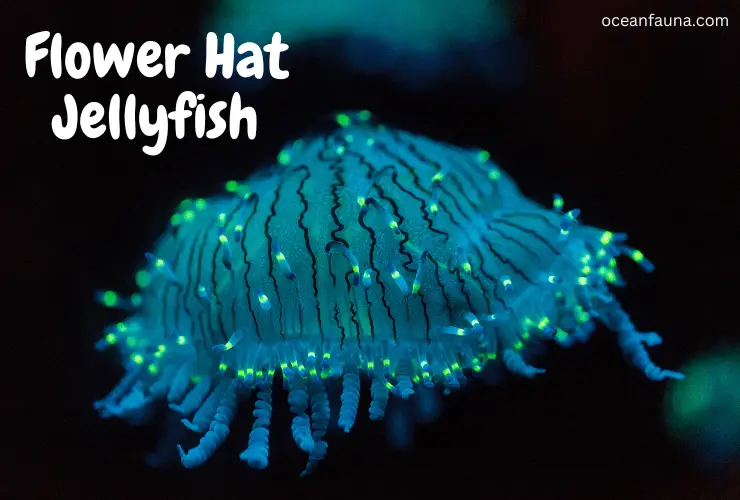There are different species of sea jellyfish, but flower hat jellyfish are worth discussing. They are known as Olindia Formosa. These belong to the class Hydrozoa and get their common name due to their resemblance to flowers. It looks like a jellyfish, but not a true jellyfish because true sea jellies belong to the class Scyphozoa.
The Flower Hat Jellyfish is a stunningly beautiful creature. It can be found in the waters of the Pacific Ocean. Its tentacles can grow up to 30 feet long. The jellyfish’s bell can reach a diameter of 12 inches. Despite its appearance, the Flower Hat Jellyfish is venomous. Its sting can cause pain and other symptoms.
Do you know what the diet of flower hat jellyfish is? Or are you curious about how they reproduce and what’s in their ecology? Don’t worry. Your hustle to read everything about these sea jellies ends in this article.
You may have seen jellyfish in seawater while swimming, but you don’t know their complete biology. Let’s discover it today!
About Flower Hat Jellyfish – A Quick Biology
The quick biology table will convey a quick look at the flower hat jellyfish’s biographical data.
| Parameters | Details |
| Scientific name | Olindias Formosus |
| Kingdom | Animalia |
| Family | Olindidae |
| Genus | Olindias |
| Phylum | Cnidaria |
| Class | Hydrozoa |
| Order | Limnomedusae |
| Species | O. Formosus |
| Habitat | These are inhabitants of southern Japan, Brazil, and Argentina |
| Life Span | It is around 5 to 6 years old. |
| Diet | These jellyfish do not have any special diets. However, zooplankton and diatoms are their main prey. |
| Synonyms | Olindias Formosa |
Description And Distribution of Flower Hat Jellyfish
Flower hat jellyfish, also known as Olindia Formosa, is a translucent species of jellyfish. Its vibrant, blue-colored tentacles add to its beauty. Its flower-like appearance increases its elegance. Its striking-colored bell shape is very unique and anyone can identify it at first sight.
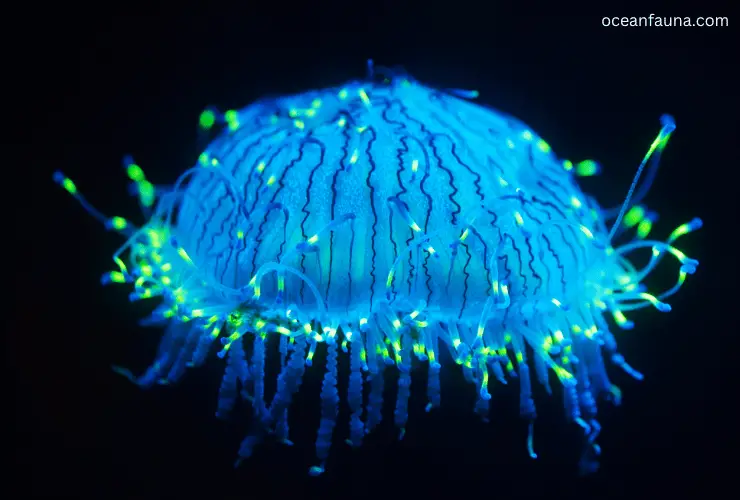
These are typically found in the Pacific Ocean. These can also be commonly seen off the coasts of Korea, China, and Japan. It’s also living in the waters of Australia. Undoubtedly, flower hat jellyfish is one of the fascinating creatures of water that is a wonder to behold.
Physical Characteristics of Flower Hat Jellyfish
The Flower Hat Jellyfish is a mesmerizing sea creature and so its physical characteristics are also mesmerizing. Let’s see some of its appearance factors that need to be mentioned here.
- Its lustrous tentacles coil around its rim.
- The bell of flower hat jellyfish is translucent and has opaque bands.
- The jellyfish can grow up to 15 cm in diameter.
- It starts small, measuring only 2 cm when first observed in the wild.
- Its fluorescent glow is stunningly beautiful.
- The jellyfish’s tentacles can stretch up to 30 feet long.
Thus, the flower hat jelly is a sight to behold with its unique colors and patterns. It is so colorful that kids love to paint it in their drawing books.
Behaviors of Flower Hat Jellyfish
Flower Hat Jellyfish rest during the daytime. They rest in algae or rocks and wait for the night. These hungry beasts then float up at night to hunt their prey. Their prey mainly consists of small fish.
There is another common behavior of flower hat jellyfish. These are solitary throughout their life. There is only one exception here. It forms polyp colonies. These polyp colonies then grow together.
These flowery creatures do not show cooperative behaviors in terms of parental involvement, sharing food items, hunting together, and caring for other youngsters.
However, these flower hat jellies’ small and often large blooms will come together and congregate on the beaches. These blooms do not cooperate, but they are a threat to coastal fishermen and beachgoers in the months of April and May.
Habitat And Range of Flower Hat Jellyfish
According to the research of the Animal Diversity Web, flower hat jellyfish are known as semi-benthic. What does it mean now? It means they live in shallow waters and also love to enjoy the below-sea levels. They live about 35 to 55 meters below the seabed.
They reside on the seafloor during the day and hunt at night. This is how they exhibit a semi-benthic nature. Their range is coastal regions, and their habitat regions include saltwater or marine, tropical, and temperate regions like the Pacific and Atlantic Oceans.
Feeding/Diet of Flower Hat Jellyfish
Flower Hat Jellyfish do not have special diet preferences. These are known as filter feeders. It means they suck up the water and absorb the nutrients that come with the flow of water. They are best at absorbing floating nutrients.
They sense the animals and other things around them easily. These sea jellyfish use their tentacles to catch and paralyze them. They transfer venom to the animals that trap them in their tentacles.
These sea animals are usually smaller in size. For example, smaller fish, zooplankton, and diatoms are their first and foremost fascinating prey.
Life Cycle of Flower Hat Jellyfish
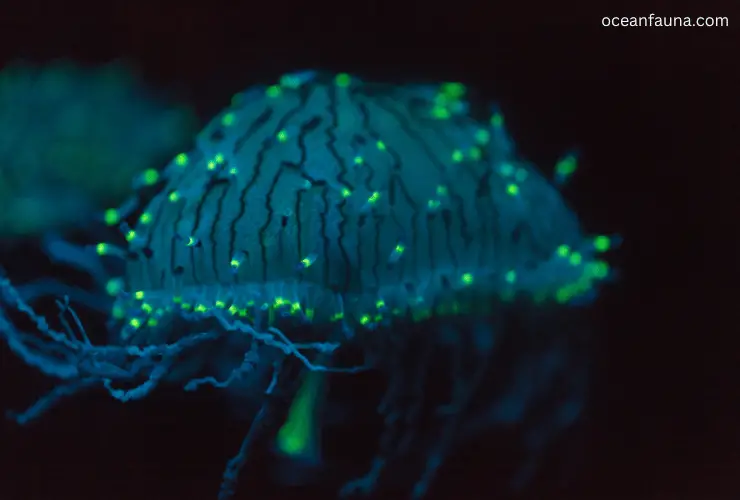
It is said that there are few details about its lifecycle. There are no Olindias hydroid species that are rarely reported from their wild habitat. However, there is a piece of good news for you guys and gals. Let’s see what that is!
The Monterey Bay Aquarium has successfully cultivated the Flower Hat Jellyfish in captivity for exhibition. It revealed various facts, like how these hydroids love to attach themselves to many other surfaces and bodies. These hydroids then form beautiful but small clusters. This is something exciting.
After a while, medusae were released. These were released at about 0.04 inches in diameter. The Flower Hat Jellyfish’s budding only happens in cooler temperatures.
Water temperatures of 15°C (59°F) or lower trigger hydroid growth and reproduction. Warmer temperatures of 20°C (68°F) or 25°C (77°F) lead to more medusae production.
This temperature pattern mirrors the sea temperature variations in its natural habitat. In aquariums, Flower Hat Jellyfish are kept in full saltwater at around 15–18 °C (59–64 °F).
The species is highly adaptable and can thrive in different water temperatures. Proper temperature regulation is crucial for successful breeding in captivity.
The Reproductive System of Flower Hat Jellyfish
Let’s see what Animal Diversity Web has researched about its reproductive system: (source)
The Flower Hat Jellyfish reproduce both sexually and asexually. They undergo external fertilization, where two individuals release their gametes into the surrounding seafloor or flora.
It results in the formation of fertilized hydroid structures with polyps. If a male and female gamete meets, a fertilized hydroid structure with polyps begins to form.
This usually happens in non-cooperative colonies of 2 to 8 individuals. Asexual reproduction occurs when the jellyfish produces buds that eventually detach and form new individuals.
This allows for rapid population growth in favorable conditions. The Flower Hat Jellyfish’s unique reproductive strategies ensure the species’ continuation in a variety of environmental conditions.
Here is another fact worth considering: the fact about the adult flower hat jellyfish. The adult form of these jellyfish lives only a few months. These are typically seen from December to July. You can see storms of adult forms of flower hat jellyfish in April and May.
Last but not least, there is no parental involvement in the reproduction and development of flower-hat jellyfish instead of releasing gametes in the environment. You can learn more about its life cycle from the Meeting Archive. They are constantly trying to discover more about this marine jelly.
Cardiovascular And Nervous System of Flower Hat Jellyfish
According to Monterey Bay Aquarium researchers, flower-hat jellyfish do not possess a heart or a brain. These marine invertebrates lack bones, heads, real eyes, and even cartilage. Still, they are known as one of the best ocean and sea predators. (Source)
Anatomy of the flower hat jellyfish
According to the research, the Flower Hat Jellyfish has a unique anatomy. Its bell-shaped body is translucent and pinstriped with opaque bands.
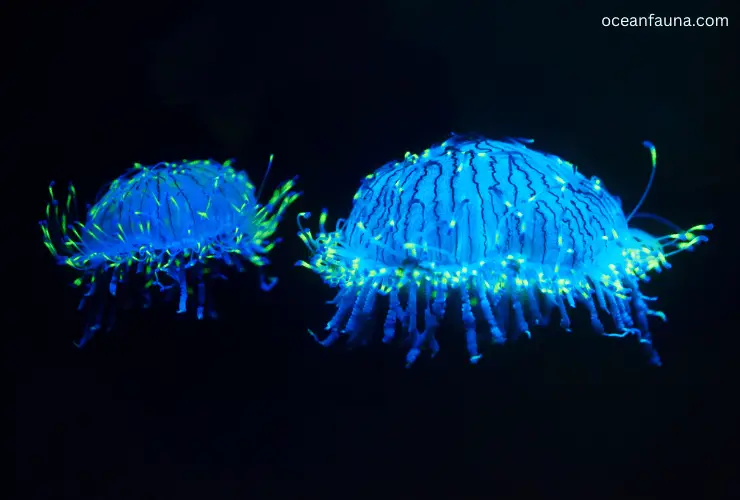
Its tentacles are lustrous and can coil around the rim when not in use. These tentacles contain stinging cells called nematocysts, which the jellyfish uses for defense and capturing prey.
Its body also contains a central digestive system with four oral arms used for feeding. Additionally, it has a nerve net but no centralized brain. It also has a simple sensory system that allows it to detect light and movement. Overall, the Flower Hat Jellyfish’s anatomy is specialized for survival and adaptation in its aquatic environment.
Ecology
Flower hat jellyfish currently do not pose any threat to the ecosystem of sea life. These are only relying on smaller quantities of small fish in the water as food sources. These are solitary predators and are known as peaceful creatures that do not harm others (without any reason) instead of eating small fish.
However, during the summer season, these jellyfish form blooms and pose a threat to humans and other jellyfish. The flower hat jellyfish can predate other species of the same jellyfish and their own class of sea jellies. This is a freaking fact because of its beautiful appearance.
These jellyfish are also economically beneficial to humans. These are displayed and sold at high rates in aquariums and captive environments.
In the meantime, the flower hat jellies are also posing harm to Argentinian, Japanese, and Brazilian coastal towns due to their blooms. Fish-relying businesses are negatively affected here.
Flower Hat Jellyfish Symbiotic Relationship
The Flower Hat Jellyfish has a fascinating symbiotic relationship with sea algae. The jellyfish can survive in low-oxygen environments because the algae inside them produce oxygen. This unique relationship benefits both parties. The jellyfish provides the algae with protection and nutrients, while the algae provide oxygen to the jellyfish.
The Flower Hat Jellyfish also serves as a host for a variety of other organisms, including small shrimp and crab species. These relationships are essential for the overall health and survival of the ecosystem. They are truly remarkable creatures with a vital role in the ocean’s delicate balance.
Predators of Flower Hat Jellyfish
There are no known predators of flower hat jellyfish right now. However, the only possible predators of these creatures are other jellyfish, like Olindias formosa. The smaller size, resting on the ocean floor, and venomous sting make it a protective kind of jellyfish.
Flower Hat Jellyfish Fun Facts
Here are some crazy and interesting, fun facts about flower-headed jellyfish:
- In Japan, they are sometimes served as a delicacy in high-end restaurants.
- The sting of a flower hat jellyfish can be treated with vinegar or a baking soda solution.
- Flower hat jellyfish have a translucent appearance that makes them difficult to see in the water.
- Flower hat jellyfish are sometimes used in traditional medicine in China and Japan.
- These jellyfish have inspired artists and designers with their colorful and unique appearance.
- They can change their color and pattern depending on the environment.
- It has been observed to exhibit vertical migration behavior.
- It has a special adaptation. It can change or squeeze its body size when food is scarce or not available. It has more chances of survival in this way.
- These colorful sea jellies are not photosynthetic.
- These are also known as beautiful fireworks of nature.
- According to a Research Gate study, its tentacles are arranged according to a mathematical order. It is also known as a phyllotactic pattern.
Does a Flower Hat Jellyfish Sting Hurt?
Yes, a mild. It’s not deadly painful. Its sting is mildly painful, and it can leave a rash where it stung. The rash looks like a minor burn. Moreover, the sting of flower hat jellyfish is not dangerous. However, it can be dangerous if not treated or ignored.
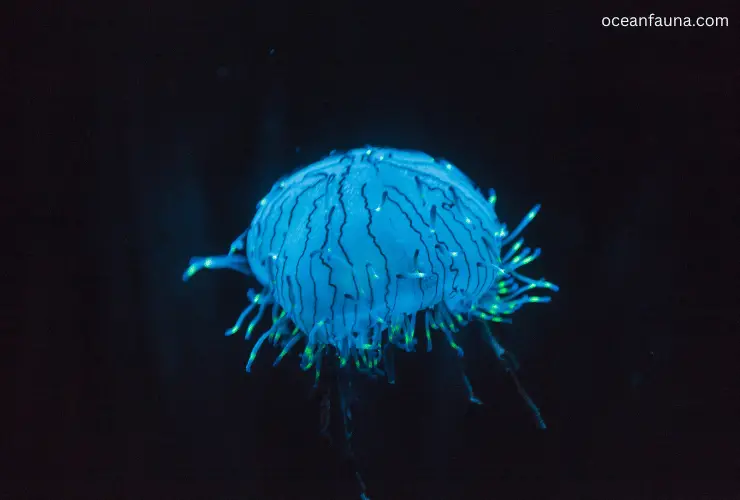
It also depends on the victim’s size and other factors, such as immunity and jellyfish species. Although their sting has mild symptoms and effects, there is still something dangerous in their cells. This needs to be worried about.
According to the Monterey Bay Aquarium, the stinging cells of flower hat jellyfish are known as the most complex and complicated. These are found only rarely anywhere in the kingdom of sea animals. So this is something to be concerned about for them.
According to the researchers of Cambridge University Press, there is a single case of human fatality due to the sting of flower-hat jellyfish in Japan in the 1970s. Cases of death are rare in humans due to its sting. However, precautions are needed to prevent getting stings from these venomous creatures. (Source)
If stung, seeking medical attention is important to alleviate symptoms and ensure proper treatment. Additionally, it is recommended to rinse the affected area with vinegar or saltwater.
You can remove any tentacles with a pair of tweezers or a gloved hand. Also, avoid using fresh water or rubbing the affected area, as this can release more venom.
Are Flower Hat Jellyfish Rare?
Flower hat jellyfish are not mentioned as rare or endangered species of jellyfish. The IUCN Red List, US Federal List, CITES, and State of Michigan List have not declared their population status yet. We can say that these are considered “Least Concern.”
Why Do Flower Hat Jellyfish Float Like a Butterfly and Sting Like a Bee?
According to the KQED organization, flowering-head jellyfish have a unique way of moving and capturing prey that has fascinated scientists for years. It was first diagnosed 100 years ago in order to understand its reproductive cycle. They float like a butterfly and sting like a bee, but how do they do it?
Their bell-shaped body and long, flowing tentacles help them swim gracefully through the water. Their tentacles are covered in thousands of tiny stinging cells called nematocysts to capture their prey. These stinging cells are so powerful that they can even stun small fish.
Flower hat jellyfish also have a special adaptation that allows them to control their buoyancy. That’s why they float effortlessly in the water. This combination of elegant movement and deadly stinging power makes flower hat jellyfish a fascinating and important part of our oceans.
The World’s First Display of a New Flower Hat Jellyfish
The Okinawa Churaumi Aquarium made history in 2020 by displaying the world’s first flower hat jelly. The jelly was bred and raised in captivity, which is a rare feat as they are difficult to breed. Visitors can now see this unique and beautiful creature up close and learn about its fascinating biology and behavior.
The aquarium has created a special exhibit to showcase the flower hat jelly. They revealed their study about its habitat, diet, and symbiotic relationships.
This achievement is a testament to the dedication and expertise of the aquarium’s staff. These achievers were committed to promoting conservation and education through their exhibits.
Moreover, flower-hat jellies were first displayed in captivity in Tennessee Aquarium, according to another source. It was never exhibited in any other aquarium before.
FAQs
Are flower hat jellyfish poisonous?
Yes, the flower hat jellyfish are poisonous aquatic animals. If you accidentally collide with them while swimming, they can sting you. They can leave a sting mark on your body and a rash right over there.
Their venom is not considered deadly. However, as we have mentioned before, they can have serious effects on your body. They are poisonous, which is why they attack and catch their prey.
What is a flower hat jellyfish known for?
After meeting this magnificent marine jelly, we have come to know that these sea jellies are known for their brilliant tentacles. Their tentacles are multicolored. They trail from a bell that is more pinstriped and translucent.
You can also find these tentacles around its Bell’s rim. The flower hat jellyfish can easily and quickly foil them. These can be swiftly unfoiled, too. It is also known for its semi-benthic nature. This mysterious sea jelly spends most of its time under the sea.
Do flower hat jellyfish glow?
Yes. Flower Hat Jellyfish glow. They are known for their elegant and fluorescent glow. Its translucent bell has opaque and dark pinstripes. Its tentacles make it a stunning jellyfish with fluorescent lights.
What is the weight of a flower hat jellyfish?
The exact and approximate weight of a flower hat jellyfish is still unknown. Its weight depends on the amount of water that it absorbs and its size.
However, we can say confidently that these are light in weight and generally smaller creatures. These jellies can grow up to 6 centimeters in diameter. Their range of length is 2 to 15 centimeters.
What oceans does the flower hat jellyfish inhabit?
The Flower Hat Jellyfish is primarily found in the following oceans:
- Pacific Ocean
- Indian Ocean
- Southern Ocean
- Atlantic Ocean
These sea jellies prefer to live close to the seafloor, where seagrass and kelp are abundant.
Conclusion
Hence, flower hat jellyfish is a small and delicate species, it’s still full of surprises. Its unique characteristics and fascinating abilities make it stand out from others. It has earned a good place in the ocean. So, if you ever encounter a flower hat jellyfish in captivity or in the wild, just watch them from a safe distance.
Always admire these whimsically named animals!

